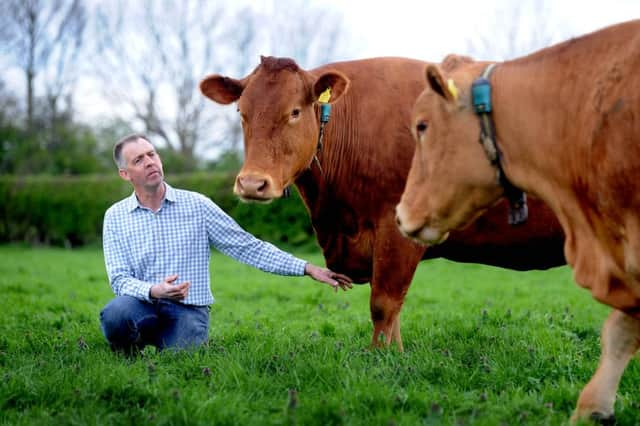North Yorkshire farmer gets to grip with new beef farm tech


Mike Powley runs a beef and arable enterprise at Elm House Farm in Green Hammerton, between York and Harrogate. The farm is also supermarket chain Asda’s training and education facility for beef in the UK and Mike has been charged with preparing talks during the day on how new technologies can benefit his sector.
Elm House Reds is a herd of just under 100 breeding cows that starts with a pedigree South Devon, which is then crossed with a Limousin producing a red cow, hence the herd name.
Advertisement
Hide AdAdvertisement
Hide AdHe calves the South Devon X Limousin cow with an Aberdeen Angus bull for the first calving, followed subsequently by the British Blue. It’s a system that works well for producing the conformation and fat content he needs of his cattle that are destined for processors ABP Food Group in York.
Mike has an open-minded approach to new technologies that might benefit his own beef operation and will be talking about some that he has tried and others that are about to create further opportunities for his fellow beef producers to enhance their businesses.
Heat time collars, bolus temperature monitors, EID tags and VIA (visual imaging analysis) at abattoir are just four of many he could have chosen.
“Heat time collars are brilliant,” he said.
“They detect when the cow comes on heat and the collars send a message to me. It saves a lot of time. My only other option would be to have three versions of my dad leaning on a gate watching them every day. It’s a system that dairy farmers have used for a while but it has had to be changed for beef farmers.
Advertisement
Hide AdAdvertisement
Hide Ad“Our cattle don’t come in every day in the same way as dairy cows so the receivers we use need to be out in the field and capable of a much greater range. Ours now work up to a distance of 500 metres where the cows graze. I have solar panels that charge the batteries for the system. I will certainly be extolling their virtue to all beef farmers at York.”
Not every new advance in technology hits the mark immediately but Mike doesn’t feel that something shouldn’t be pursued. He has tried using bolus temperature monitors.
“You insert the bolus, made up of a printed circuit board and battery inside a plastic container similar to a gun cartridge in the cow’s throat that ends up in their reticulum and sits there.
“The principle of it is to detect changes in temperature so that you can better predict calving time and also get to know when there is a problem before it is immediately recognisable from the outside.
Advertisement
Hide AdAdvertisement
Hide Ad“Changes in temperature when a cow is ill begin a day or two before clinical signs of illness and this helps detect it so that it can be dealt with quickly.
“My only problem with it is that with my cattle it is difficult to get a signal from inside. If you turn up the transmitter you run the risk of damaging the cow. The theory of it is great but my feeling is that the bolus needs a little longer to get it absolutely right for my usage.”
EID tags are not compulsory for cattle but Mike believes they offer beef farmers another recording instrument that for an industry that is paid on getting things right should not be ignored.
“There is a cliché in the beef sector that if you don’t measure it you can’t manage it. All it takes is a quick scan of the EID to capture and then analyse your data to help you achieve what you’re after. Why wouldn’t anyone want this information? EID is a no-brainer in my book. We should all use it.”
Advertisement
Hide AdAdvertisement
Hide AdVisual Imaging Analysis is the system by which every beef producer is liable to be paid through abattoirs such as ABP in the future.
“VIA will be used by ABP in York when their new abattoir is constructed. It puts together a 3D image of what all the cuts are like and how much there is of each cut with its respective value.
“This will also then provide an explanation of why he or she is or isn’t producing what the market requires.”
The National Beef Association’s Beef Expo 2015 at York Auction Mart is open to both farmers and the general public, and takes place Thursday, May 21. For more details and for ticket information, visit the Expo website on www.nationalbeefassociation.com/Beef-Expo-2015